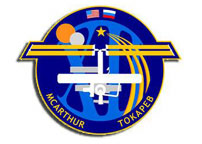NASA Space Station Status Report 21 October 2005

Growing increasingly familiar with their microgravity home and laboratory in space, the 12th international space station crew turned its attention to experiment work, began preparations for the first space station-based spacewalk using U.S. suits since 2003 and captured spectacular images and video of the latest tropical cyclone in the Atlantic basin, Hurricane Wilma.
Expedition 12 Commander and NASA Station Science Officer Bill McArthur and Flight Engineer Valery Tokarev this week began reviewing procedures for the extravehicular activity, or spacewalk, they will make on Nov. 7 using U.S. spacesuits and the Joint Quest airlock. The two priority tasks for the 5½-hour spacewalk are installation of a new video camera on the far end of the station’s P1 (port) truss structure and removal of a probe that measured the electrical potential around the station from the top of its P6 truss element.
The station’s atmosphere was repressurized with oxygen from storage tanks on the Progress supply ship today as Russian specialists prepare a troubleshooting plan to recover the Elektron, the primary oxygen generation system on the space station. The Elektron, which creates oxygen by breaking down water into its oxygen and hydrogen components, stopped working late last week when its supply of water was depleted sooner than was expected.
A Russian commission of technical specialists is looking into the cause of the abort of a planned altitude reboost Tuesday using Progress fuel and thrusters. Mission managers believe Russian navigation computers properly shut down the thrusters when they lost information on how those thrusters were actually performing. A test firing of the thrusters in question is planned for next Wednesday to gather more data for Russian engineers troubleshooting the issue.
This week McArthur checked out a new device to analyze exhaled gases inside the station. After more than eight years of design, development and testing on Earth by U.S. and European Space Agency (ESA) scientists, the Pulmonary Function System – originally slated to be launched to the station inside ESA’s science laboratory Columbus – was delivered by space shuttle Discovery in July integrated into the second Human Research Facility (HRF). The first HRF was launched inside Destiny in February 2001.
McArthur and Tokarev conducted the first of three sessions with the Renal Stone experiment by collecting urine samples for later return to Earth and logging all of their food and drink consumed during a 24-hour period. This ongoing experiment investigates whether potassium citrate – proven to minimize kidney stone development on Earth – can be used to reduce the risk of kidney stone formation for crewmembers in space.
Because urine calcium levels are typically much higher in space, space travelers are susceptible to an increased risk of developing kidney stones. An understanding of the crew’s diet during the urine collection timeframes will help researchers determine if the excess calcium in the urine is due to diet or a response to the microgravity environment.
NASA’s payload operations team at the Marshall Space Flight Center coordinates U.S. science activities on the space station.
McArthur and Tokarev will be in orbit for six months conducting experiments, at least two spacewalks and overseeing arrival of the next Progress supply vehicle in December. They also will relocate their Soyuz crew module to free the Russian Pirs docking port for a later spacewalk. Pirs doubles as an airlock and docking module.
For information on the crew’s activities aboard the station, future launch dates, and station sighting opportunities from anywhere on the Earth, visit:
The next ISS status report will be issued Thursday, Oct. 27, or earlier if events warrant.








